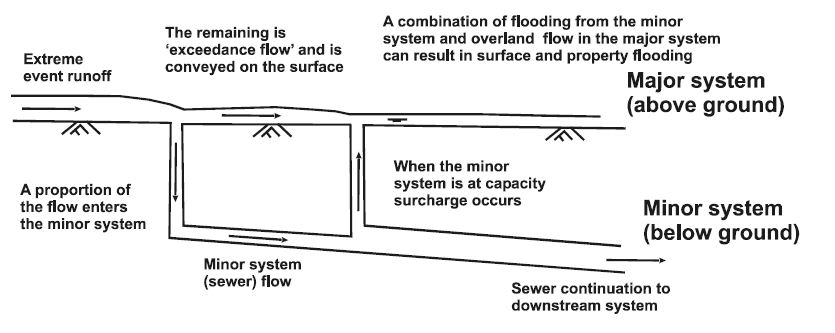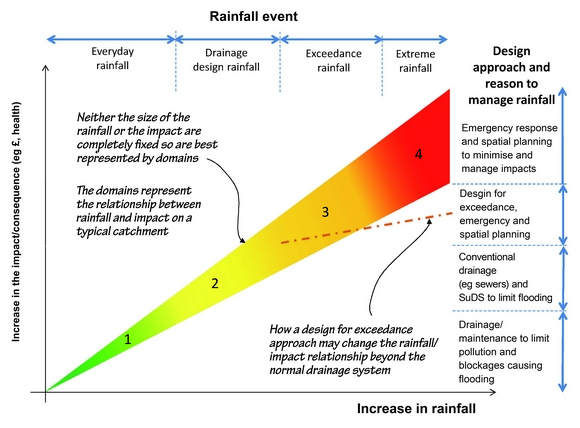- Delivering SuDS
- Using SuDS
- Background
- SuDS principles
- Benefits of SuDS
- Benefits of SuDS
- Why developers should choose SuDS
- Flood risk management
- Water quality management
- Biodiversity & ecology
- Amenity
- Air quality
- Building temperature
- Carbon reduction and sequestration
- Crime
- Economic growth
- Enabling development
- Flexible infrastructure/climate change adaptation
- Education
- Groundwater recharge
- Health and well being
- Pumping wastewater
- Rainwater harvesting
- Recreation
- Tourism
- Traffic calming
- Treating wastewater
- SuDS components
- SuDS components overview
- Source control
- Swales & conveyance channels
- Filtration
- Infiltration
- Retention & detention
- Wetlands
- Inlets, outlets and control structures
- SuDS performance & monitoring
- Delivery
- The costs & benefits of SuDS
- Adoption & maintenance of SuDS
- Legislation & regulation
- Design guidance
- Retrofitting SuDS
- Drainage exceedance
- Home
- Delivering SuDS
- Drainage exceedance
- Background
- Processes
Processes
Traditionally, urban drainage systems are designed to meet a particular and specified level of service, known as the target level (normally expressed as a frequency of property flooding). A level of protection of one in 100 years (annual probability of 0.01 being equalled or exceeded) for internal property flooding might be regarded as a suitable target for a new development. This can be delivered using SuDS or (less desirably) traditional piped drainage system with appropriate checks to ensure property flooding is adequately manage (once implemented Schedule 3 of the Flood and Water Management Act will make SuDS mandatory). Following such checks, the design may be amended to ensure that the desired level of protection is achieved across the drainage area. Existing drainage systems typically do not achieve the same level of service as that required for new systems. This is in part due to the structural deterioration and siltation of the existing network. More often, it is due to a drainage network carrying increased flows from expanding urban areas. Once system performance falls below an acceptable level, known as the trigger level, early rehabilitation will be planned.
The formal or designed drainage system (piped or SuDS) is often referred to as the minor system (as depicted in the first image). For a piped system, the conveyance capacity will normally be greater than the pipe full capacity, since additional conveyance can be generated as flow backs up in manholes causing surcharging. The resulting slope of the hydraulic gradient can be greater than the gradient of the pipes themselves, forcing more flow through the system. A similar effect can occur with SuDS.

Once the conveyance capacity of the minor system is exceeded, surface flooding will occur. The excess flow that appears on the surface is known as the exceedance flow.
The rainfall events that result in exceedance flow are known as extreme events. Exceedance flow will be conveyed on the ground by surface flood pathways. These may be roads, paths or depressions in the surface. The system of above ground flood pathways, including both open and culverted watercourses, is known as the major system.
The connection between the minor and major systems is complex and can really only be properly represented by a computer simulation model of both systems. Even then, current capability of modelling above ground flood pathways is limited. A simplified graphical representation of the interaction between the minor and major system is shown below (see figure 2).

Managing different types of rainfall
Different approaches can be used to manage different types of rainfall from what occurs ‘every day’ through to extreme rainfall that may only occur once in a lifetime but can cause devastation. In the past, exceedance may not have typically been designed for or managed. Linking the type of rainfall to the resulting impacts helps to demonstrate the best approaches to managing rainfall in a given location.
Figure 3 adapts the three points approach (outlined by Fratini et al (2012)) to create a ‘four domains’ approach. The three points approach has helped explain to stakeholders the best ways to manage different types of rainfall events. Domains are used rather than points as they better represent the ‘type’ of rainfall and the resulting impact that can arise. The probability of rainfall occurring in any given year relates to the x-axis. The typical impact that rainfall can create is indicated on the y-axis.
As a step change in rainfall occurs, there is a different approach to managing the rainfall. Joining the different domains together helps explain that the management of surface water and flood risk is a continuum in the long term. The domains describe the following aspects of managing different types of rainfall:
Domain 1: everyday rainfall. Here the drainage system manages everyday rainfall of low intensity and volume, typically to limit the impact on the environment and often for local uses. Providing systems remain are effectively maintained, hazards are rare (eg blockages) and likelihood of flooding is low. In this region, the benefits of using rainfall for resources, like irrigating green infrastructure predominate.
Domain 2: design rainfall. This is what we typically design our drainage systems to achieve. For example, new surface water sewers use a 1 in 30 chance of rainfall that may occur in any given year and highway drainage typically 1 in 5 year chance of rainfall that may occur in any given year. Adequate maintenance of the drainage systems means there will be no hazards other than those pre-defined and acceptable.
Domain 3: exceedance rainfall. Here we choose to manage exceedance events on the surface using a range of interventions and multi-functional land use (as defined in this report and CIRIA C635 Designing for exceedance in urban drainage). This is using both structural (physical measures) and non-structural responses, as well as emergency planning. It occurs when the functional drainage system cannot cope with the full amount of rainfall (due to capacity or blockage). Domain 3 bridges the gap of interventions required to manage the exceedance and larger extreme events.
Domain 4 – extreme rainfall. Coping with extreme rainfall relies upon urban resilience, spatial planning and emergency planning. Exceedance measures may contribute to managing extreme event flows through good spatial planning using, for example, blue water corridors, building resilient infrastructure and emergency planning and response. Domains 3 and 4 share similar approaches, however, the magnitude of the events mean the impacts in Domain 4 will be greater.

Types of designing for exceedance
Designing for exceedance falls into two types:
Type 1 retrofitting - minor adjustments to the local landscape that deal with existing and relatively simple problems.
Type 2 structured and strategic exceedance management - complex drainage problems and often a wide range of urban infrastructure and systems that are interconnected and interdependent (can apply to new build, regeneration and retrofit).
Read more on:



